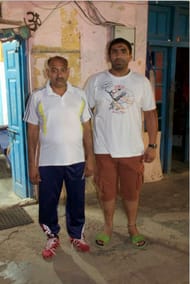Guru Hanuman Akhara is a quaint rustic place nestled in North Delhi Ridge, standing in stark contrast to the posh Roshanara Club situated right across the road. This Akhaada, built by Guru Hanuman in 1919, has housed and honed some of the best wrestlers in the country, including Dara Singh, Satpal Singh, commonwealth Gold medalist Subhash Verma
Padmashree, Dronacharya Guru Hanuman lived a simple ascetic life, practicing “brahmacharya” and vegetarianism till he died in 1999 at the age of 94.
Mahasingh Rao, who’s been coaching young grapplers a the Akhara since 1984, Coach Maha Singh feels that this era has not seen a man like Guru Hanuman, and is unlikely to see one in the future.
Contribution to Indian Sports
Despite having a small space of 800 yards, combined with a severe lack of infrastructure and funds, the akhara has produced 15 Arjun awardees, 1 Dhyaanchand, 7 Dronacharya, 3 Padma Shri, 1 Padma Bhushan awardee.
A few years back, the Government offered a larger space for the wrestling school, but the students and staff firmly believe that the land and its mitti is blessed, and that Guru Hanuman continues to be present in spirit among them. They refused to relocate to a bigger, modern space.
In 2010, the Government of India awarded the Khel Protsahan Puruskaar to Hanuman Akhara for their lifelong contribution towards Indian wrestling. No other institution or person has bagged this honour.
Olympic Aspirations
It was a lifelong aspiration of Guru Hanuman to see one of his pupils bring home an Olympics medal. Even though Rajiv Tomer bagged a gold and silver in Commonwealth Games, and even represented India in the 2008 Olympics, this aspiration has remained unfulfilled as of now.
One of Guru Hanuman’s most famous students include Padma Bhushan, Dronancharya awardee Guru Satpal Singh – coach of two-time Olympic medalist, Sushil Kumar.
“If Guruji hadn’t set up this akhara, we wouldn’t have had Satpal Singh, and without Satpal, we probably wouldn’t have Sushil,” says Coach Maha Singh.
Continuing Legacy
Arjuna Awardee, Hind Kesari Rajiv Tomar learnt wrestling from Guruji here along with his brother and father, Shyam Singh Tomar.
Recipient of the biggest wrestling awards in India, including Rustam-e-Hind, Tomar feels fortunate to be associated with this legendary Akhara. “I’ve been here more than 2 decades and feel blessed to have spent a few years with Guru ji.
“We still miss him, but I am glad that coach Maha Singh ji has been taking good care of the Akhara and running it smoothly. Even today it is the one of the most well-known akhaaras in the world.
Last year his nephews, Abhishek (9) and Ujwal Tomar (8) students of Leelawati School, Delhi joined the institution. They come here every day after school, and credit their enthusiasm and skills to coach Maha Singh, who also taught their Olympian uncle, Rajiv.
Ascetic lifestyle of the grapplers
Most of the wrestlers here are still in school and joined the Akhara full time when they were teens, like Pawan who came here from U.P when he was 15. His friend Sumit who joined around the same time bagged a bronze medal in Asian Championship and aims to get a better medal next time.
They wake up at 4 a.m. to start their morning practice and then attend school. Post school, they get a short break after which practice and training is resumed.
Since most of their time is spent inside the Akhara itself, the students have limited avenues for leisure and entertainment as Cinema and TV are considered distractions. They are suggested not to use smartphones, and some of them have no phones at all.
They also have a fixed diet chart consisting of simple vegetarian staples like pulses, dry fruit, dairy products and vegetables.
Facilities provided
“We have facilities for Olympics-style wrestling as well as Indian free-style Kushti, or Dangal. For training we provide traditional Indian exercises like rope climbing, dragging heavy logs across the clay pits, as well as modern gym equipment.
“Apart from the Olympic and free-style, in India there is a third category of wrestling called Greek-o-Roman”, says Coach Maha Singh. The wrestlers also have the option of going to a full-fledged gym nearby for training.

